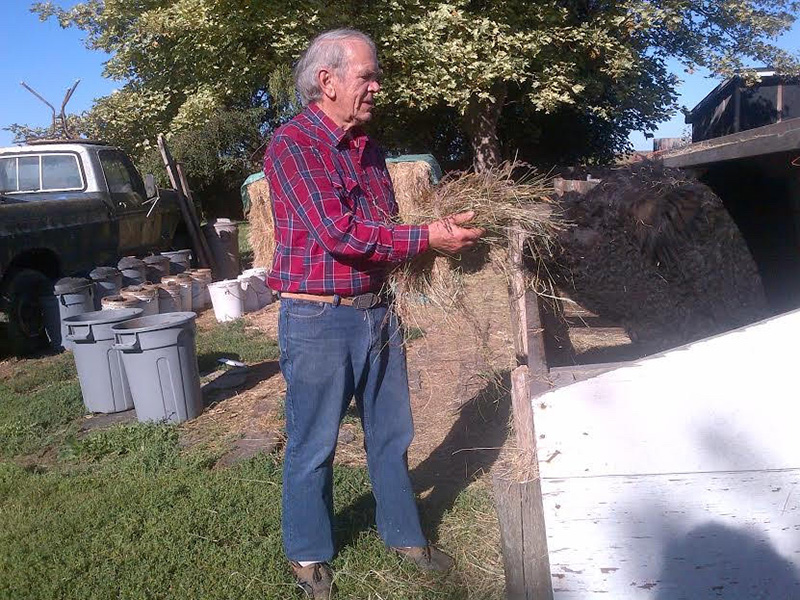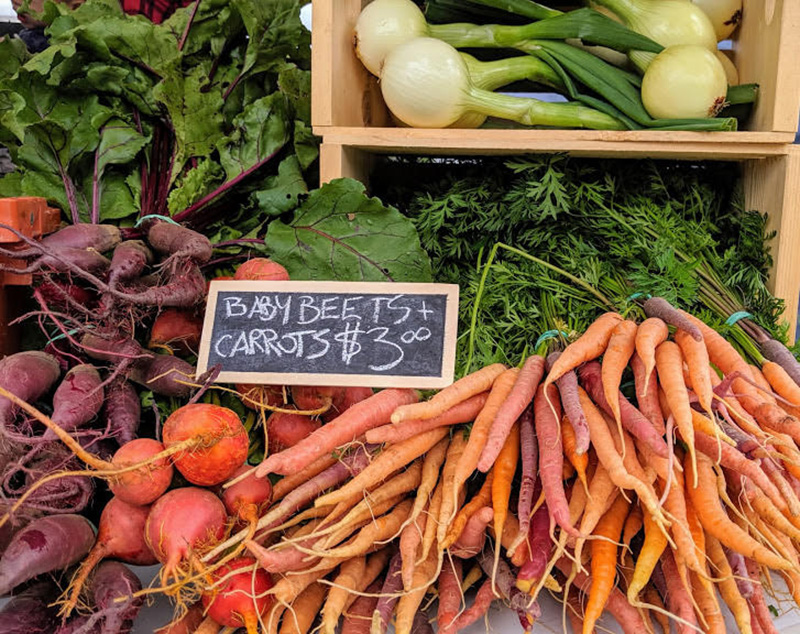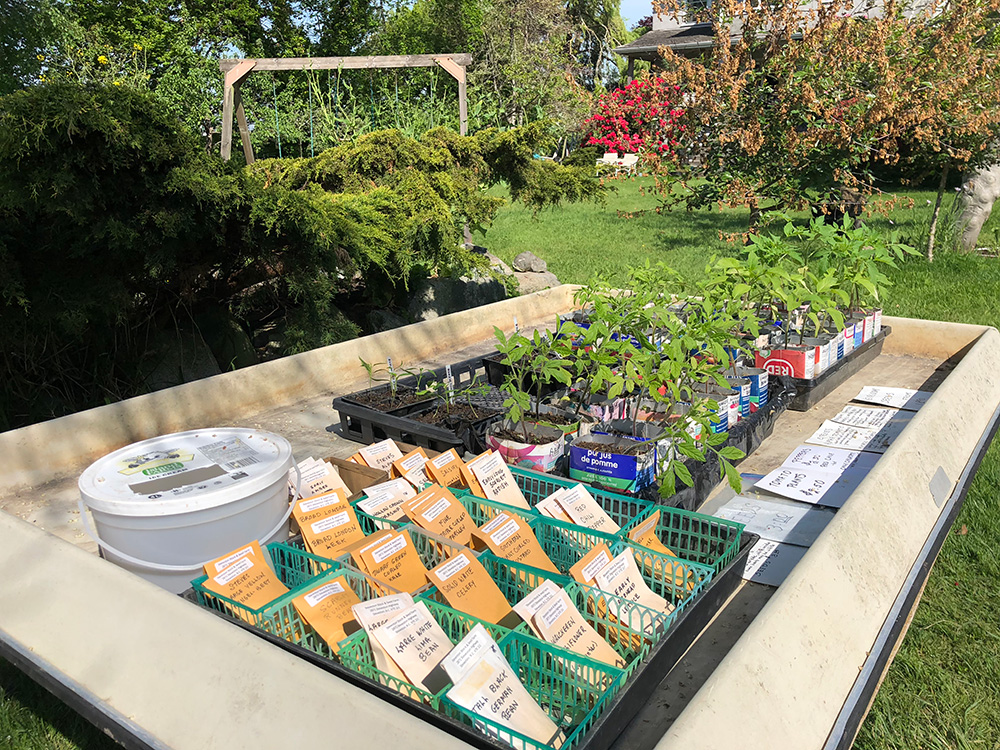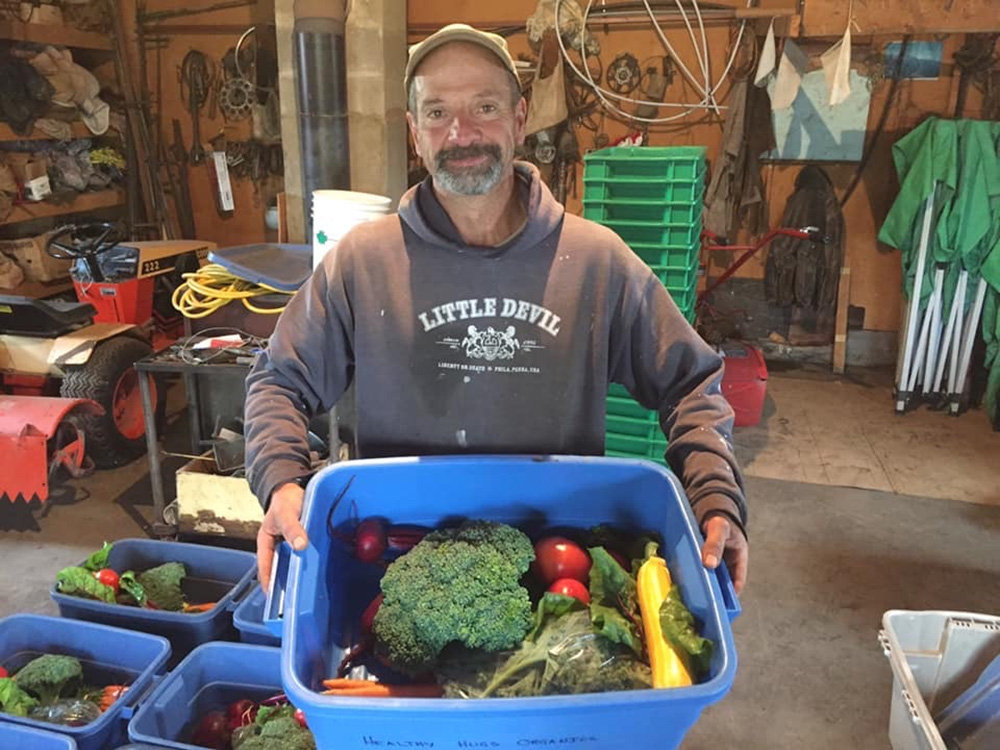It’s mid-afternoon and Harold Steves has taken a break from planting seeds to take my call. He picks up while washing his hands.
“I’m washing off dirt,” he reassures me, “not COVID-19.”
Steves has been a Richmond city councillor for more than 50 years, with a break to be an MLA in the early 1970s. During his short time in provincial politics, he helped establish the Agricultural Land Reserve, created in 1973 to protect millions of hectares of arable land. He established the province’s first community garden the same year.
Farmland preservation, urban agriculture and food security are his passions. He’s also putting his hands where his heart is — in the earth.
“I figured a long time ago that the best thing for me to do was to be involved in actually doing food security rather than just talking about it,” says Steves, who has been working around the clock on his family farm.
Food security and the call to “buy local” have taken on new significance in the time of COVID-19. The pandemic has brought into sharp focus B.C.’s dependence on foreign imports of all kinds, particularly with the U.S. government’s recent attempt to block exports of protective equipment like face masks.
Empty grocery store shelves have reminded Canadians how vulnerable we are to food shortages, and how dependent we are on imports — not just from our southern neighbour, but the world.
And that inspired many residents to turn to local producers or their own green thumb for sustenance this growing season.
“It’s a wake-up call. Something that we said could happen, is happening,” Steves says. “The potential for a crisis like climate change and COVID-19 has been anticipated for a long time. It just came sooner than we expected.”
When the Agricultural Land Reserve was created, B.C. growers produced 86 per cent of the fruit and vegetables consumed in the province, Steves says. Half a century later, only 43 per cent is grown in the province.
Today, B.C. imports 84 per cent of its broccoli and cauliflower, 76 per cent of its strawberries and 69 per cent of its lettuce and root crops from California, he says.

And as California’s agriculture falters, first because of drought caused by climate change and now due to the pandemic, Steves worries about our food supply.
“People are realizing that we only have three days of food supply in Vancouver,” he says. “We’ve concentrated on the factory farms and the large farms for too long when our production, for years, was always the small farmers. I think that’s coming back and we have to promote it.”
Relying on temporary foreign workers
B.C.’s agricultural industry — like California — relies on cheap labour. Statistics from 2017 show increasing dependence on temporary foreign workers, with about 7,500 agriculture workers coming from outside the country. Nationwide, Canada’s agriculture sector imports tens of thousands of temporary foreign workers each year, most of them in Ontario and Quebec.
But the pandemic is raising questions about that reliance. Health authorities have been grappling with how to reconcile the need for a seasonal agriculture workforce with travel restrictions designed to reduce the flow of COVID-19 into the country. On March 20, the federal government exempted temporary foreign workers from its air travel restrictions, though they are still subject to a mandatory 14-day isolation period.
Less than two weeks later, provincial health officer Dr. Bonnie Henry announced that 14 foreign workers at a West Kelowna nursery had tested positive for the virus. By this week, the outbreak had grown to 26* workers.
Susana Caxaj, an assistant professor at the University of Western Ontario who studies migrant workers in the Okanagan, said Bylands Nurseries — where the outbreak occurred — is believed to be among the better employers using foreign labour in B.C.’s agricultural industry.
“What if there are farms where there is no interest in even reporting symptoms by the employers’ part?” she says. “What we’re seeing is all the ways that it is legal to cram workers together in bunkhouses, side by side, that already promotes increased risks to their health and is made exponential by the pandemic.”
On April 7, the agriculture ministry released requirements for farms employing temporary foreign workers. In addition to increased handwashing and physical distancing, it requires sleeping bunks be spaced at least two metres apart and employees who become sick be moved to separate accommodation.
Caxaj is among a group of experts calling on governments to enforce public health measures for migrant agricultural workers — or else put the program on pause.
She worries that the people at the heart of our domestic food supply are also among the most vulnerable to falling ill from COVID-19.
“I am really terrified that we are going to bring them onto farms to make them really sick or die,” she says. “If they want migrant agricultural workers here to work on a farm, they need to treat them as the essential workers they are and they can’t be sacrificial lambs for a failed experiment. Because we still won’t have food on the table plus we’ll have a lot of sick people.”
If farmers are going to bring migrant workers into Canada this year they should have to prove they can safely accommodate them within the new guidelines, Caxaj says.
“Even in a typical season, these workers aren’t really included in public health planning. For years we’ve asked public health leaders to visit the farms,” she says. “In B.C., those inspections are done by private inspectors and that health perspective isn’t brought into monitoring potential challenges on a farm.”
Instead of putting workers’ lives at risk, she suggests residents could temporarily forego some of the fruits and vegetables we’ve grown to expect.
Looking to buy locally grown food
As an alternative, many B.C. residents are looking to their own backyards for fresh produce.
Heather O’Hara is the executive director of the BC Association of Farmers' Markets. Some market vendors have said that demand for their product has tripled this season, she says.
“Our food vendors are busy,” O’Hara says. “Right now, we don’t have any supply chain issues, but if we do, that’s where the rubber hits the road.”
The association supports 145 member markets, which in turn support local producers in selling their products.
But this year markets have hit a speed bump. While farmers markets are deemed essential services on the province’s COVID-19 list, they are also social hubs in many communities and present a challenge to rules restricting gatherings to under 50 people.

That’s especially true in the province’s north, where the start of outdoor market season marks the end of a long winter.
“It draws a really significant crowd,” said Margo Peill, who manages the Skeena Valley Farmers Market in Terrace. “We wanted to do everything we could to prevent large gatherings of people and really promote the physical distancing that’s been recommended.”
The Terrace market was scheduled to start early May. For the time being, its board of directors has decided to cancel all physical markets. It will re-evaluate in late May, Peill says.
In the meantime, it is among the many markets taking advantage of a new online platform offered by BC Association of Farmers' Markets to connect with customers.
The Ministry of Agriculture announced two weeks ago it would provide $55,000 to fund the initiative through its Buy BC program. It uses Local Line, an online platform designed to support food suppliers in selling directly to consumers. Markets with an online option can be found by using the “online market” feature on the BCAFM website. Orders are placed through the platform; how goods are distributed is up to individual markets.
In Terrace, producers will make their own arrangements with customers.
“It’s going to be a big adjustment for vendors because a lot of them really enjoy that face-to-face interaction. It’s definitely going to be a shift, but vendors are really excited that something is happening and they still have a way to connect to their customers,” Peill says.
“I’m a pretty big advocate for always supporting local. I think supporting small business, supporting local producers, really trying to shrink our food system to be more regional and really reducing the distance our food travels [is] always important. Now more than ever, if that’s something that people can do, I think that’s great.”
O’Hara says most markets are working on some form of online venue, which also allows non-food vendors — which are not included in the “essential” designation — to reach customers. Whether the online platform complements or replaces in-person markets is up to individual markets.
Two hours down the highway in Smithers, the Bulkley Valley Farmers Market is continuing its outdoor markets as what it describes as a “grab-and-go food re-supply station.” It suggests pre-ordering with vendors to speed up shopping and is also working to move some vendors online.
Joe Hug is a Smithers-based farmer who plans to sell through the market, as well as local retail outlets and weekly garden boxes, which he begins distributing in July. He’s figuring out how Healthy Hugs Organics can upscale production to meet increased demand.
“Our vegetable boxes are almost full already and usually that doesn’t happen until maybe June,” says Hug, who has been busy planting seeds in his greenhouse. He’s increased seedlings by nearly 4,000 plants, up 10 to 15 per cent from previous years and is currently calculating how many additional garden boxes he could distribute.
“Now we’re in a situation where we find out how dependent we really are on important sources from far away. Not just food, but our medical supplies,” he says. “We’ve got to realize, things that we really need to sustain us, like medical supplies and food, we need to be able to produce here.”
Growing your own food
In addition to buying local, many B.C. residents are looking to grow their own veggies. In a video posted to its website, Vancouver-based West Coast Seeds describes “a huge surge in demand for seeds and gardening products” in response to COVID-19.

“Suddenly, it seems like gardening, preparation and food security are more urgent than ever,” the video says. The company says it’s working overtime to keep up with orders, but increased demand combined with reduced staffing to accommodate physical distancing is creating shipping delays of up to 45 days.
While seasoned gardeners plant seeds or anxiously await supplies, some communities are encouraging residents to pick up gardening tools for what may be the first time. In Bella Bella, Heiltsuk non-profit Qqs Projects Society is providing seeds and soil to residents in what has been dubbed “Granny Gardens” — a modern take on the Victory Gardens of the first and second world wars.
“There’s a ton of anxiety and uncertainty in the air. We all feel it. Bella Bella is remote and our supply chains and connectivity to the outside world feel tenuous as we see the commercial services that bring our freight, groceries, and so much more being scaled back,” executive director Jess Housty said in a Twitter post.
“The #GrannyGarden movement is an act of love in a time when many of the things we rely on have become unstable. We’re growing love and growing food and carrying on our ancestors’ work while we do it.”
A community sawmill is producing planter boxes and will be providing online gardening tutorials.
The City of Victoria is also equipping novice gardeners with the tools to begin growing. Councillors in the “City of Gardens” voted to repurpose some of its greenhouse space to growing food rather than flowers. The seedlings will be distributed to residents along with soil and educational resources.
“We are transitioning 20 percent of the capacity so that we can grow 50,000 to 75,000 food plants from seedlings that we’ll distribute to the public along with growing materials and education materials,” Coun. Jeremy Loveday says. The focus has been on crops that do well in B.C.’s coastal climate and can be grown in containers.
“Living on an island, I think there’s already an awareness of food security issues. This crisis has brought that more acutely into focus. I’ve heard from and seen many residents who want to get their hands dirty and be a part of the solution.”
Steves applauds Victoria’s efforts in producing the seedlings. The next step, he says, will be finding more land.
In Richmond, 400 people are currently on a waiting list for community garden plots. The city is working to address the shortfall with 50 to 60 new plots expected to become available this year. Council is currently discussing an additional 200 plots for Richmond’s Garden City Lands, 55 hectares of green space located within the Agricultural Land Reserve. They are unlikely to be ready before next year.
At Steveston Stock and Seed Farm, Steves has adapted to sell eggs and seeds through a farm-gate honour system. “And we’re just about out,” he says. “We sold double what we normally sell in the first month. We weren’t anticipating anything like this.”
His grass-fed beef is sold out until June, he adds.
“The number of people wanting locally adapted vegetable varieties was already growing. Now it is increasing more rapidly.”
*Story updated on April 15 at 3:36 p.m. to adjust the number of foreign workers that have tested positive for the virus to 26 from 20. ![]()
Read more: Local Economy, Food, Coronavirus, Labour + Industry
















Tyee Commenting Guidelines
Comments that violate guidelines risk being deleted, and violations may result in a temporary or permanent user ban. Maintain the spirit of good conversation to stay in the discussion.
*Please note The Tyee is not a forum for spreading misinformation about COVID-19, denying its existence or minimizing its risk to public health.
Do:
Do not: